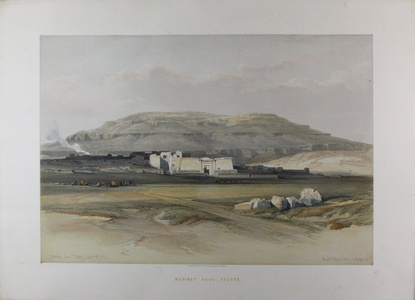| Method | Lithograph with tint stone and hand colour |
| Artist | Louis Haghe after David Roberts |
| Published | London, Published by F.G. Moon, 20 Threadneedle St., May 1st, 1847. |
| Dimensions | Image 329 x 489 mm, Sheet 450 x 637 mm |
| Notes |
A general view of the Mortuary Temple of Ramesses III at Medinet Habu, on the West Bank of the Nile at Luxor, Egypt. The temple, very similar in size, scale, style, and location to the Mortuary Temple of Ramesses II, is famous for its well-preserved wall reliefs, particularly those commemorating the King's defeat of the enigmatic 'Sea Peoples,' variously identified as different sea-faring groups of Mediterranean origin, and often conjectured to have been Greeks, Lycians, and Phoenicians. In the Christian era, the central courtyard of the temple was converted into a Coptic church, with many of its wall reliefs removed or recarved to suit, though this church has since been removed. Roberts' view provides a view of the whole structure of the Mortuary Temple. At centre is the massive First Pylon, with the Migdol Tower to the left. On either side of the temple, Arab mud-brick houses have encroached on the precinct, particularly around the monumental enclosure wall. Two teams of camels use the road in front of the site, and the cliffs behind are dotted with the openings of rock-cut tombs. David Roberts RA (24 October 1796 – 25 November 1864) David Roberts' monumental works on the Middle East: The Holy Land and Egypt & Nubia, is considered the greatest lithographically illustrated works issued in the 19th century. Roberts' masterpiece was issued in 41 parts over seven years in three states; tinted, tinted proof and coloured and mounted on card. The prints were masterfully lithographed by Louis Haghe, to whom Roberts paid tribute in glowing terms, `Haghe has not only surpassed himself, but all that has hitherto been done of a similar nature. He has rendered the views in a style clear, simple and unlabored, with a masterly vigor and boldness which none but a painter like him could have transferred to stone'. Abbey regarded the work as `one of the most important and elaborate ventures of nineteenth-century publishing, and.the apotheosis of the tinted lithograph'. David Roberts was born in Stockbridge near Edinburgh, and at the early age of 10 apprenticed to Gavin Buego, a house painter. He continued to work for Buego after his apprenticeship had been completed, carrying out work on imitation stonework and panelling at Scone Palace and Abercairney Abbey. By 1818 Roberts had become assistant scene painter at the Pantheon theatre in Edinburgh, moving on to work in theatres in Glasgow and finally in late 1821 to Drury Lane theatre in London, where he worked with Clarkson Stanfield. Both artists exhibited at the Society of British Artists, Royal Academy and British Institution, and by 1830 Roberts was firmly established as a topographical artist and was able to give up his theatre work. In these early years he toured the continent and Scotland, and in 1832-33 visited Spain. In 1838 he made plans for his journey to the Near East, inspired by a love of artistic adventure; departing in August 1839 for Alexandria, he spent the remaining part of the year in Cairo, visiting the numerous tombs and sites. In February of the following year he set out to cross the desert for the Holy Land by way of Suez, Mount Sinai and Petra arriving in Gaza, and then on to Jerusalem, concluding his tour spending several months visiting the biblical sites of the Holy Land, and finally returning to England at the end of 1839. The drawings of his tour were submitted to F.G. Moon in 1840 who arranged to bring out a work illustrative of Scripture History, paying Roberts £ 3,000 for the copyright of the sketches, and for his labour in supervising Louis Haghe's lithography. Both the exhibition of his original watercolours and the subsequent published work were an immediate success and confirmed his reputation as an architectural and landscape artist of the highest order. Abbey Travel 272, 63 . Yesterday and Today; Egypt: Plate 76. Condition: Dirt build-up to edges of sheet, some light foxing in margins, not affecting the image. Two dark stains and a small crease in upper right of image. |
| Framing | unmounted |
| Price | £600.00 |
| Stock ID | 42707 |

